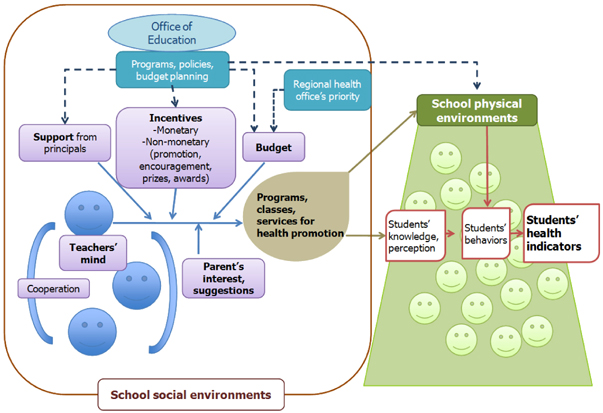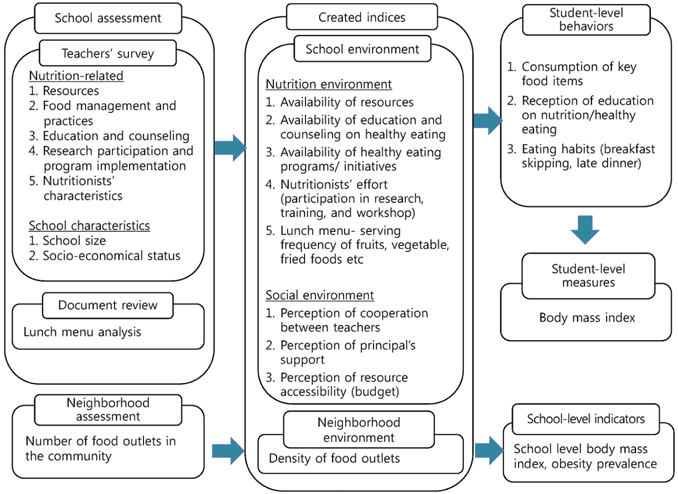Nutr Res Pract.
2017 Oct;11(5):402-411. 10.4162/nrp.2017.11.5.402.
Creating a school nutrition environment index and pilot testing it in elementary and middle schools in urban South Korea
- Affiliations
-
- 1Department of Food Science and Nutrition, Hallym University, Life Science Building Room 8519, 1 Hallymdaehak-gil, Chuncheon, Gangwon 24251, Korea. sopark@hallym.ac.kr
- 2Dietary and Nutritional Safety Policy Division, Food and Consumer Safety Bureau, Ministry of Food and Drug Safety, Osong Health Technology Administration Complex, Chungbuk 28159, Korea.
- 3Physical Education and Health Division, Lifelong and Vocational Education Bureau, Seoul Metropolitan Office of Education, Seoul 03178, Korea.
- 4Global Health Institute, School of Public Health, Xi'an Jiaotong University Health Science Center, Shaanxi 710061, PR China.
- 5Center for Human Nutrition, Global Center on Childhood Obesity, Bloomberg School of Public Health, Johns Hopkins University, 615 North Wolfe Street Baltimore, MD 21205, USA.
- KMID: 2390133
- DOI: http://doi.org/10.4162/nrp.2017.11.5.402
Abstract
- BACKGROUND/OBJECTIVES
The role of a school's nutrition environment in explaining students' eating behaviors and weight status has not been examined in an Asian setting. The purpose of this study was to create a school nutrition environment index and to pilot test the index in elementary and middle schools in urban South Korea.
SUBJECTS/METHODS
This study used a mixed-methods approach. Environment assessment tools were developed based on formative research, which comprised literature reviews, in-depth interviews, and focus group discussions. Key elements from the formative research were included in the assessment tool, which consisted of a structured survey questionnaire for school dietitians. Fifteen school dietitians from 7 elementary and 8 middle schools in Seoul completed the questionnaire.
RESULTS
The formative research revealed four main sections that guided a summary index to assess a school's nutrition environment: resource availability, education and programs, dietitians' perceptions and characteristics, and school lunch menu. Based on the literature reviews and interviews, an index scoring system was developed. The total possible score from the combined four index sections was 40 points. From the 15 schools participating in the pilot survey, the mean school nutrition-environment index was 22.5 (standard deviation ± 3.2; range 17-28). The majority of the schools did not offer classroom-based nutrition education or nutrition counseling for students and parents. The popular modes of nutrition education were school websites, posters, and newsletters.
CONCLUSIONS
This paper illustrates the process used to develop an instrument to assess a school's nutrition environment. Moreover, it presents the steps used to develop a scoring system for creation of a school nutrition environment index. As pilot testing indicated the total index score has some variation across schools, we suggest applying this instrument in future studies involving a larger number of schools. Future studies with larger samples will allow investigation of the validity and reliability of this newly developed tool.
Keyword
MeSH Terms
Figure
Reference
-
1. Kubik MY, Lytle LA, Hannan PJ, Perry CL, Story M. The association of the school food environment with dietary behaviors of young adolescents. Am J Public Health. 2003; 93:1168–1173.
Article2. Cullen KW, Thompson DI. Texas school food policy changes related to middle school a la carte/snack bar foods: potential savings in kilocalories. J Am Diet Assoc. 2005; 105:1952–1954.
Article3. Cullen KW, Zakeri I. Fruits, vegetables, milk, and sweetened beverages consumption and access to à la carte/snack bar meals at school. Am J Public Health. 2004; 94:463–467.
Article4. Kubik MY, Lytle LA, Story M. Schoolwide food practices are associated with body mass index in middle school students. Arch Pediatr Adolesc Med. 2005; 159:1111–1114.
Article5. Terry-McElrath YM, O'Malley PM, Delva J, Johnston LD. The school food environment and student body mass index and food consumption: 2004 to 2007 national data. J Adolesc Health. 2009; 45:S45–S56.
Article6. Foster GD, Sherman S, Borradaile KE, Grundy KM, Vander Veur SS, Nachmani J, Karpyn A, Kumanyika S, Shults J. A policy-based school intervention to prevent overweight and obesity. Pediatrics. 2008; 121:e794–e802.
Article7. Bartholomew JB, Jowers EM. Increasing frequency of lower-fat entrees offered at school lunch: an environmental change strategy to increase healthful selections. J Am Diet Assoc. 2006; 106:248–252.
Article8. Zhang J, Xue H, Cheng X, Wang Z, Zhai F, Wang Y, Wang H. Influence of proximities to food establishments on body mass index among children in China. Asia Pac J Clin Nutr. 2016; 25:134–141.9. Chiang PH, Wahlqvist ML, Lee MS, Huang LY, Chen HH, Huang ST. Fast-food outlets and walkability in school neighbourhoods predict fatness in boys and height in girls: a Taiwanese population study. Public Health Nutr. 2011; 14:1601–1609.
Article10. Centers for Disease Control and Prevention (US). State level SHPPS 2014 data files and documentation [Internet]. Atlanta (GA): Centers for Disease Control and Prevention;2014. cited 2017 February 1. Available from: http://www.cdc.gov/healthyyouth/shpps/2006/data/state.htm.11. Gittelsohn J, Evans M, Helitzer D, Anliker J, Story M, Metcalfe L, Davis S, Iron Cloud P. Formative research in a school-based obesity prevention program for Native American school children (Pathways). Health Educ Res. 1998; 13:251–265.
Article12. Carter MA, Swinburn B. Measuring the 'obesogenic' food environment in New Zealand primary schools. Health Promot Int. 2004; 19:15–20.
Article13. Lytle LA. Measuring the food environment: state of the science. Am J Prev Med. 2009; 36:S134–S144.14. Lytle LA, Fulkerson JA. Assessing the dietary environment: examples from school-based nutrition interventions. Public Health Nutr. 2002; 5:893–899.
Article15. Cullen KW, Hartstein J, Reynolds KD, Vu M, Resnicow K, Greene N, White MA;. Improving the school food environment: results from a pilot study in middle schools. J Am Diet Assoc. 2007; 107:484–489.
Article16. French SA, Story M, Fulkerson JA, Hannan P. An environmental intervention to promote lower-fat food choices in secondary schools: outcomes of the TACOS Study. Am J Public Health. 2004; 94:1507–1512.
Article17. Park S, Kang JH, Lawrence R, Gittelsohn J. Environmental influences on youth eating habits: insights from parents and teachers in South Korea. Ecol Food Nutr. 2014; 53:347–362.
Article18. Pope C, Ziebland S, Mays N. Qualitative research in health care. Analysing qualitative data. BMJ. 2000; 320:114–116.
Article19. Patton MQ. Qualitative Research & Evaluation Methods. 4th ed. Thousand Oaks (CA): SAGE Publications;2015.20. Park S, Choi BY, Wang Y, Colantuoni E, Gittelsohn J. School and neighborhood nutrition environment and their association with students' nutrition behaviors and weight status in Seoul, South Korea. J Adolesc Health. 2013; 53:655–662.
Article21. Ministry of Education & Human Resources Development (KR). National Plan for Students' Health Promote. Seoul: Ministry of Education & Human Resources Development;2007.22. Gittelsohn J, Sharma S. Physical, consumer, and social aspects of measuring the food environment among diverse low-income populations. Am J Prev Med. 2009; 36:S161–S165.
Article23. Ministry of Education and Science Technology (KR). National Plan for Students' Health Promotion: School Health and School Lunch. Seoul: Ministry of Education and Science Technology;2012.24. Ministry of Education (KR); Ministry of Health and Welfare, Center for Disease Control and Prevention. Evaluation Report on the Online Youth Health Behavioral Survey 2015. Cheongju: Korea Centers for Disease Control and Prevention;2015.25. Riediger ND, Shooshtari S, Moghadasian MH. The influence of sociodemographic factors on patterns of fruit and vegetable consumption in Canadian adolescents. J Am Diet Assoc. 2007; 107:1511–1518.
Article
- Full Text Links
- Actions
-
Cited
- CITED
-
- Close
- Share
- Similar articles
-
- Development and application of an evaluation tool for school food culture in elementary, middle, and high schools in Gyeonggi Province, South Korea
- School Dietitian’s Job Satisfaction and Job Importance According to the School Types in Sejong City
- The Perception for Management of School Foodservice Using of Environmentally Friendly Agricultural Products of Elementary School Children's Mothers in Gunsan
- Study on the status of food allergy management and importance-performance analysis about precautions of food allergy in school foodservice according to the school types in Jeonbuk area
- Nutrition Management Examined by Plate Waste Measurement: A Comparison with Elementary Schools and Middle Schools in the Changwon Area



